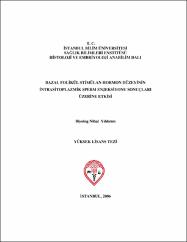| dc.contributor.advisor | Koyutürk, Meral | en_US |
| dc.contributor.author | Yıldırım, Nihal | |
| dc.date.accessioned | 2014-06-04T09:58:04Z | |
| dc.date.available | 2014-06-04T09:58:04Z | |
| dc.date.issued | 2006 | |
| dc.date.submitted | 2006 | |
| dc.identifier.citation | Yıldırım, Nihal. (2006). Bazal Folikül Stimülan Hormon Düzeyinin İntrasitoplazmik Sperm Enjeksiyonu Sonuçları Üzerine Etkisi. Yayımlanmamış yüksek lisans tezi. İstanbul : İstanbul Bilim Üniversitesi, Sağlık Bilimleri Enstitüsü. | en_US |
| dc.identifier.uri | https://hdl.handle.net/11446/80 | en_US |
| dc.description | İstanbul Bilim Üniversitesi, Sağlık Bilimleri Enstitüsü, Tıbbi Biyoloji ve Genetik Ana Bilim Dalı Yüksek Lisans Programı | en_US |
| dc.description.abstract | İntrasitoplazmik sperm enjeksiyonu (ICSI) erkek kaynaklı infertilite tedavisi için
yaygın olarak kullanılan yardımcı üreme teknigidir. Yardımcı üreme tekniklerinde amaç,
uygun tedavi protokolu ve yöntemleri kullanarak kaliteli gamet hücreleri ile embriyo ve
gebelik elde edilmesidir. Yasla birlikte overlerdeki germ hücre havuzu azalmaktadır.
Bununla birlikte kadınlarda ilerleyen yas ile paralel olarak azalan over rezervi,
gonodotropin stimülasyonuna yanıtın azalmasına neden olmakta ve tedavide basarı sansını
olumsuz olarak etkilemektedir. Yıllar içerisinde over progresif olarak folikül havuzunu
kaybeder ve inhibin seviyesi düser, buna karsılık adenohipofizden folikül stimülan
hormon (FSH) salınımı artar. Bu nedenle günümüzde erken fazda ölçülen bazal FSH
degerleri over rezervinin önemli bir belirteci olarak kabul edilmektedir. FSH degeri, oosit
rezervinin yanı sıra kaliteli oosit ovulasyonu açısından önem tasır. Bazal FSH
ölçümlerinin in vitro fertilizasyon (IVF) uygulamalarında gebelik sonuçları üzerine etki
eden önemli bir belirteç olarak kullanılabilecegini bildiren pekçok çalısma mevcuttur.
Bu çalısmada, kadın hasta bazal FSH düzeyinin ICSI sonuçları üzerine etkilerinin
incelenmesi amaçlanmıstır. ICSI tedavisine alınan 99 çift çalısma grubumuza dahil edildi.
Hastalar bazal FSH <10 IU/ml ve FSH >10 IU/ml olan kadın ve normospermili erkek
hastalar ile bazal FSH <10 IU/ml, FSH >10 IU/ml olan kadın ve oligospermili erkek
hastaların olusturdugu dört grup altında toplandı. Bazal FSH degeri <10 IU/ml olan
normospermili ve oligospermili gruplarda, toplanan oosit sayısı ve metafaz II (MII) oosit
sayısı, FSH degeri >10 IU/ml olan her iki gruba göre artmıs olarak bulundu ve gruplar
arası istatistiksel anlamlılık izlendi. Metafaz I (MI) ve germinal vesikül (GV) içeren oosit
gelisimi, fertilizasyon oranları ve takiben elde edilen embriyoların 2. ve 3. gün iyi ve kötü
kalite embriyo oranları arasında istatistiksel bir anlamlılık saptanmadı. Gebelik oranları
bazal FSH < 10 IU/ml olan normospermili grupta 33.3, oligospermili grupta 40.0, FSH >10
IU/ml olan gruplarda ise sırasıyla 18.8 ve 26.7 olarak bulundu. Bazal FSH degerleri >10
IU/ml olan grupta gebelik oranları düsme göstermesine karsın istatististiksel olarak
anlamlılık tespit edilmedi. | en_US |
| dc.description.abstract | Intracytoplasmic sperm injection (ICSI) is an assisted reproductive technic widely
used for the treatment of male originated infertility. The goal in assisted reproductive
technics is to obtain quality oosite and embryo by using appropriate treatment protocols
and methods. The pool of germ cells in the ovaries decreases by age. However the ovary
reserves that decrease in parallel with increased age in women cause the decrease in the
response to the stimulation applied by gonodotrophines and negatively affects the chances
of success in treatment. In years, the ovary progressively looses the follicle pool and
inhibin level decrease, conversely the follicle stimulating hormone (FSH) releasing
increase from adenohypophysis. For this reason the FHS values measured in the early
phase are accepted as an important indicator of the ovary reserves. FSH value also carries
importance for the ovulation of quality oosits in addition to the oosit reserves. There are
several reports that basic FSH value can be used as an important indicator having affected
on the pregnancy results in the in vitro fertilization (IVF) applications.
This study aims to examine the effects of the basal FSH level in women on the ICSI
results. 99 couples accepted for ICSI treatment were included in our study. The patients
were grouped into four with basal FSH < 10 IU/ml, FSH >10 IU/ml women and normo
spermic patients and basal FSH <10 IU/ml, FSH >10 IU/ml women and oligospermic
patients. The oosit numbers in the groups with basal FSH value < 10 IU/ml normosperm
and oligosperms and the metaphase II (MII) oosit counts were found to have increased
relative to the two groups with FSH values >10 IU/ml and there was statistical significance
between the groups. There was no statistical significance between metaphase I (MI) and
germinal vesicule (GV) oosit development, fertilization rates and between the good and
bad quality ratios of the following embryos in the 2nd and 3rd days. Pregnancy rates were
33.3 in the normosperm group and 40.0 with oligosperm groups with FSH < 10 IU/ml and
18.8 and 26.7 respectively in the FSH >10 IU/ml groups. Even though there was reduced
pregnancy in the group with basal FSH values >10 IU/ml a statistical significance was not observed. | en_US |
| dc.language.iso | tur | en_US |
| dc.publisher | İstanbul Bilim Üniversitesi, Sağlık Bilimleri Enstitüsü. | en_US |
| dc.rights | info:eu-repo/semantics/openAccess | en_US |
| dc.subject | embriyo | en_US |
| dc.subject | FSH | en_US |
| dc.subject | fertilizasyon-in vitro | en_US |
| dc.subject | ovulasyon | en_US |
| dc.subject | embryo | en_US |
| dc.subject | fertilization-in vitro | en_US |
| dc.subject | ovulation | en_US |
| dc.title | Bazal folikül stimülan hormon düzeyinin intrasitoplazmik sperm enjeksiyonu sonuçları üzerine etkisi | en_US |
| dc.title.alternative | The correlation between basal follicular hormone levels and intracytoplasmic sperm injection results | en_US |
| dc.type | masterThesis | en_US |
| dc.department | DBÜ, Sağlık Bilimleri Enstitüsü, Tıbbi Biyoloji ve Genetik Ana Bilim Dalı | en_US |
| dc.contributor.authorID | TR140953 | en_US |
| dc.relation.publicationcategory | Tez | en_US |
| dc.identifier.yoktezid | 203174 | en_US |


















